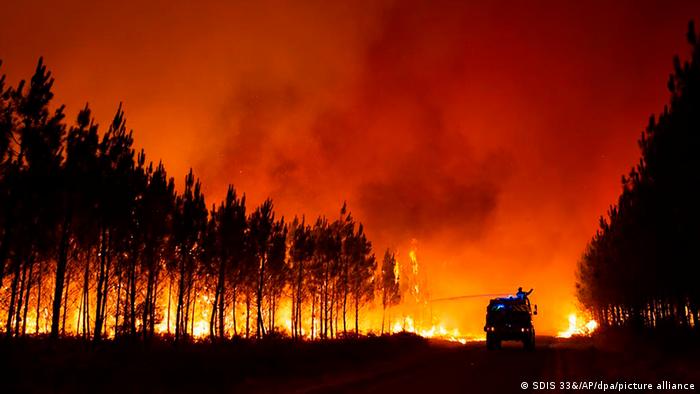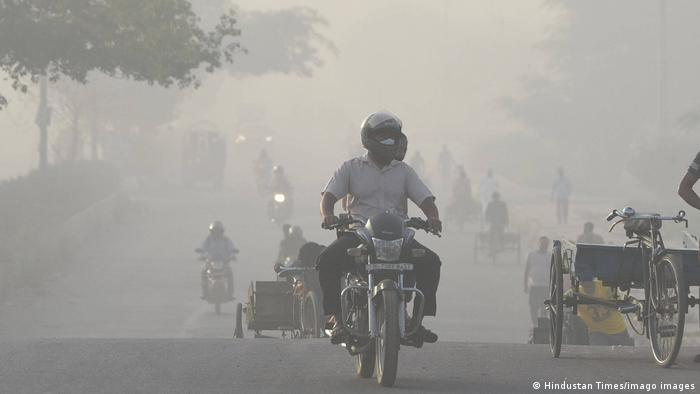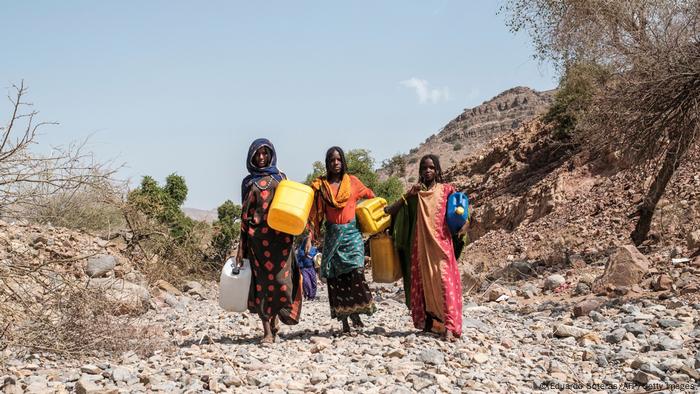Extreme wildfires pollute the air people breathe
Drought and heatwaves are fueling a widening global fire front that is choking the air we breathe. A new report labels the pollution a 'climate penalty.'

Through the haze: The connection between climate change, wildfires
and air pollution is becoming clearer
Longer droughts and more frequent heatwaves driven by global heating are fueling wildfires that worsen air quality, according to a new report by the World Meteorological Organization (WMO).
The wide-ranging consequences for both human health and ecosystems have been labeled a "climate penalty."
Polluted air could impact a quarter of world's population
"As the globe warms, wildfires and associated air pollution are expected to increase, even under a low-emissions scenario," said WMO Secretary-General Petteri Taalas. "In addition to human health impacts, this will also affect ecosystems as air pollutants settle from the atmosphere to Earth's surface."
"This is a foretaste of the future because we expect a further increase in the frequency, intensity and duration of heatwaves, which could lead to even worse air quality, a phenomenon known as the 'climate penalty'," he said.
This penalty refers in part to how climate change amplifies the production of ground-level ozone.
This kind of ozone differs from high-altitude ozone, which shields the Earth from the sun's rays. Ground-level or surface ozone is a harmful pollutant that fouls the air people breathe.
The WMO report focuses on wildfire smoke in 2021, when wildfires across western North America and Siberia increased levels of particulate small matter, or PM2.5 (particulate matter with a diameter of 2.5 micrometers or smaller) that is harmful to human health.

Wildfires were still burning out of control in Spain in late August
Climate change and air pollution interconnected
Air quality and climate are interconnected because the chemicals that degrade air quality are most often emitted together with greenhouse gases, according to the WMO. When forests or fossil fuels are burned and release carbon dioxide, they also emit nitrogen oxide, which can react with sunlight to create harmful ozone and nitrate aerosols.
These pollutants also impact natural ecosystems, negatively affecting clean water, biodiversity, carbon storage and crop yields.
The regions with the greatest projected climate penalty are predominantly in Asia and are home to around 25% of the world's population.
If global temperatures rise by 3 degrees Celcius (by 5.4 degrees Fahrenheit) from preindustrial levels by the end of the century, which is in line with current projected emissions, surface ozone levels are expected to increase across heavily polluted areas.
This includes a 20% rise across Pakistan, northern India and Bangladesh, and a 10% rise across eastern China.
Most of the ozone increase will be due to growing emissions from fossil fuel combustion, but around 20% will come from climate change impacts including increasing numbers of heatwaves.
A global, cross-border crisis
The WMO report was published ahead of the International Day of Clean Air for blue skies on September 7.
This year's theme is The Air We Share, which focuses on the transboundary nature of air pollution.
An estimated 9 out of 10 people around the world breathe air that doesn't meet World Health Organization air quality guidelines, according to the United Nations Environment Program (UNEP) that organizes the event.
Stressing the need for collective accountability and action, UNEP highlights the need for international and regional cooperation to enact mitigation policies that tackle air pollution.
As the WMO report notes, mitigating climate change through worldwide carbon neutrality will be key to reducing heatwaves and the wildfires that accompany them.
While the total burned area worldwide has declined in the last 20 years — in part as forest and grassland areas recede — it has increased in parts of North America, the Amazon and Australia as the planet heats up.

As the world heats, fires will increasingly cause pollution in Asia
like this heavy smog in New Delhi, India
Governments fund fossil fuels over air quality
Less than 1% of global government aid budgets allocated between 2015-2021 were devoted to projects tackling outdoor air pollution around the world.
Rather, four times as much was pumped into projects that prolong fossil fuel use, according to the Clean Air Fund, a London-based initiative that tackles air pollution.
African nations received just 0.3% of development assistance for air pollution between 2015 and 2021, despite poor air quality being the continent's second largest killer after HIV/AIDS, finds a new report published by the initiative on Wednesday.
As governments prepare to meet in Egypt for COP27, campaigners are calling for greater funding and policy commitments for alternative, low-carbon energy solutions that tackle air pollution and climate change.
"We have to cut support for fossil fuel projects," said Clean Air Fund Executive Director Jane Burston.
"Funding air pollution reduction makes good sense. It's a joined up approach to improving human health and tackling climate change at the same time."

CLIMATE CRISIS: A WORLD LACKING WATER
Famine risk on the Horn of Africa
Ethiopia, Kenya and Somalia are currently experiencing their worst drought in over 40 years after successive failed rainy seasons. The dry conditions have led to a severe food security issue in the region, with 22 million people at risk of starvation. More than 1 million people have been forced to leave their homes during the drought, which is expected to continue for months.
123456789
Edited by: Kate Hairsine
No comments:
Post a Comment